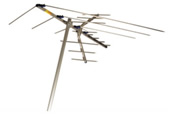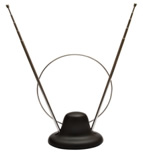No matter what kind of home entertainment setup you have, it probably features a clear cable or satellite picture, even if it’s not digital or high definition, and a remote control that means having to get up only for the necessities (input and output).
In the 1960s and 1970s chez Schirf, I didn’t grow up with the crisp lines and vibrant colors that Comcast delivers today to my high-definition box and 32-inch TV. To capture the available TV signals broadcast by stations in Western New York and Ontario, Canada, we used a TV antenna.
I don’t know about anyone else’s TV antenna, but ours needed nearly constant adjustment, which depended on the station we were watching. In good weather, the three major network stations in Buffalo (ABC, CBS, and NBC) came in clearly most of the time, while the local UHF stations and those across the way in Ontario were marred by visual “snow” and aural static. Depending on weather and other conditions, it might not be watchable.
That’s where turning the antenna came in.

On Saturday afternoons at 1 p.m., my dad watched wrestling broadcast by a Kitchener, Ontario station. That meant that, at some time before 1, after lunch and washing the dishes, one of us would be dispatched to turn the antenna, while some else stood near the TV and the window to call out directions: “No, getting worse . . . turn the other way . . . keep going . . . no, too far . . . back . . . that’s good . . . there!”
The antenna was at the top of a long pole set into a pipe in the ground, which I’m sure was my dad’s do-it-yourself setup. The pole was tall, the hole had widened over the years, and the antenna made the whole thing a little top heavy, especially if there was a wind. It was heavy and hard to turn, and had to be turned slowly. I remember standing outside in the weather, fighting the wind. Of course, the same wind could sometimes turn the antenna enough to make the picture snowy, and sometimes the picture would alternate between bad and worse as the wind rocked the antenna. The picture might be bad but tolerable if the program on was one you really wanted to watch. When it was unwatchable, it was time to find an alternative channel or turn off the TV — there was no Internet to turn to.

In the early 1990s, Chicago Cable TV mistakenly cut off my cable. To my surprise, Walgreens still sold rabbit ears with a UHF loop, so I bought a pair. My apartment was at the end of a courtyard, which may have been why they didn’t work very well. I kept them until I moved in 2003, when I tossed many non-necessities. I’m not sure how they’d connect to the flat-screen LG TV I bought in July 2010.
TV antenna are still sold; the FCC provides a guide to “Antennas and Digital Television.” When I’ve traveled through small towns and rural areas, I’ve seen some antennas, although they are outnumbered by satellite dishes. I spotted these two on the return trip from Kankakee River State Park, although I’m guessing that no one has to go out to turn them and that no one has to stand inside by the window calling out directions about picture quality. And that, like the rest of us, these residents are continuing the time-honored tradition of complaining that “there’s nothing good on TV.” Whether you have eight channels or 800, there’s only so much “reality” you can take.

I’d settle for curling in Canada.





